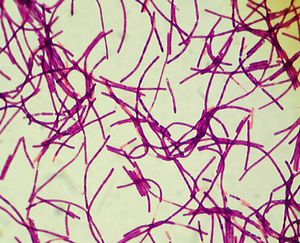The pathogenesis of Bacillus anthracis
History/Introduction
By [Tony Amolo]
At right is a sample image insertion. It works for any image uploaded anywhere to MicrobeWiki. The insertion code consists of:
Double brackets: [[
Filename: PHIL_1181_lores.jpg
Thumbnail status: |thumb|
Pixel size: |300px|
Placement on page: |right|
Legend/credit:
Closed double brackets: ]]
Other examples:
Bold
Italic
Subscript: H2O
Superscript: Fe3+
Anthrax is a highly contagious disease caused by the bacteria named Bacillus anthracis from the family Bacillaceae. It is the only obligate bacillus pathogen in vertebrates as other Bacillus species are harmless saprophytes. Based on phenotype, it can be classed with Bacillus cereus, Bacillus thuringiensis and Bacillus mycoides as it is difficult to differentiate this group based on their 16S rRNA sequences (10). The genus includes thermophilic, psychrophilic, acidophilic, alkaliphilic, halotolerant, and halophilic, which are capable of growing at temperatures, pH values, and salt concentrations at which few organisms could survive.(4) Named by Hippocrates for the black skin lesions it causes in its cutaneous form, anthrax( Greek: “coal) was well known in the ancient past and is featured in two of the ten plagues of the Old Testament.(1) It generally affects warm blooded animals including humans. Aloys Pollender, who is credited with discovering the disease called the organism “chyllus corpuscles” in the blood spleen, and carbuncle fluid of cows, which had died of the disease (2). Anthrax was extensively studied in the 1870s by Robert Koch and Louis Pasteur. Koch used suspended drop culture methods to trace the complete life cycle of the bacteria and found that the spores formed could remain viable for long period of adverse environments (3). It became a matter of public interest after the bioterrorist attacks in the USA during the autumn of 2001 where five letters containing small quantities of anthrax spores contaminated more than 30,000 people, killed five people and infected 17. (13)
Transmission
Include some current research, with at least one figure showing data.
Symptoms
Include some current research, with at least one figure showing data.
Structure and Metabolism
Include some current research, with at least one figure showing data.
Pathogenicity
[1] Hodgkin, J. and Partridge, F.A. "Caenorhabditis elegans meets microsporidia: the nematode killers from Paris." 2008. PLoS Biology 6:2634-2637.
Authored for BIOL 238 Microbiology, taught by Joan Slonczewski, 2015, Kenyon College.
Vaccines and Cure/Current Research
Include some current research, with at least one figure showing data.


